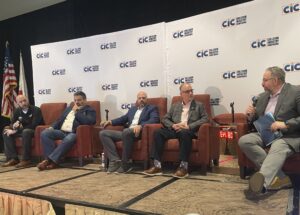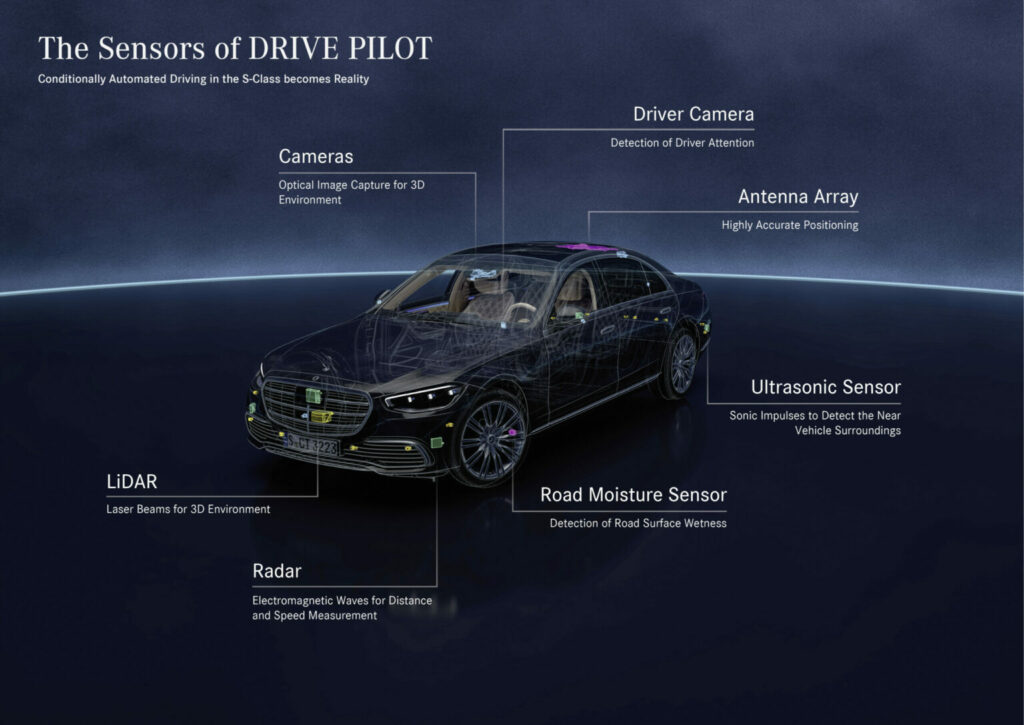
Radar Compliant Paint: Refinishing more than cosmetic job as vehicle technology advances
By onAssociations | Collision Repair | Repair Operations | Technology
As technology advances, automotive refinishing has become more than a cosmetic function — it could be the difference between life and death.
The refinishing step in the repair process needs a new level of precision when it involves a vehicle with radar and sensors used for safety features, a Collision Industry Conference Parts and Materials Committee panel said during a Palm Springs, California meeting Jan. 17.
Benito Cid, Mercedes-Benz USA collision programs manager, said the company continues advancing technology that uses sensors, cameras, radar and more, included as part of the technology suite in its Level 3 automated driving feature, Drive Pilot, in California and Nevada in 2023.
“All of these things require a clear line of sight,” Cid said. Ensuring the repair process and products don’t interrupt the line of site of those systems is why “looking at the procedures is even more important at this point.”
Repairers can’t repaint some parts with sensors, Cid said. Sometimes, replacing the part is the only option.
Other colors have a maximum amount of layers of coating such as primer, paint and clear, he said. Some of these parts can only be painted one additional time.
Cid showed a slide with multiple colors that can’t be repainted in a repair. The colors ranged from white, beige, gray and black. He also displayed the Mercedes-Benz procedure for information on painting bumpers with radar sensors, which specifies paints approved for refinishing the bumper.
Any other color is not approved for refinishing.
“We can’t just say it’s gray or white,” Cid said. “We have to be looking at this and make sure we have the right information. You are sending someone out onto the road with this vehicle that may or may not function as it should.”
Ryan Brown, western technical manager for AkzoNobel, said repairers who work on structural damage know the importance of checking an OEM manual.
“Paint has always been cosmetic,” Brown said. “It is no longer just cosmetic.”
AkzoNobel, a paint and coating company, tests their products in conjunction with OEMs to find the correct formulas needed to keep sensors working, Brown said.
OEMs make and document correct procedures in their manuals, but it is the repairer’s responsibility to follow that procedure, he said.
“There’s an astoundingly low amount of them [refinish technicians] who have ever used or seen one of these manuals,” Brown said. “Make sure to get it into the hands of people refinishing the car.”
Manufacturer procedures vary for each make and model, Brown said. He added that the information can change.
“We constantly have to go back and access this information because there may be changes to it in the future,” Brown said.
Brown said manuals used to be printed out and left nearby for technicians to grab. However, as technology advances quickly, it is important to find the most up-to-date manual online each time.
After finding the correct information on OEM portals, repairers must know how to select the correct color formula for both color match and radar functionality, Brown said.
A slide Brown showed said repairers must also know the radar transparent color search steps in MIXIT — AkzoNobel’s cloud color database. He said Radar Transparent Formulas can be found in MIXIT module access via the MIXIT help center.
Doing these steps is important because calibration isn’t always accurate, he said.
“Make sure those sensors retain their functionality and integrity,” Brown said.
Brown listed factors refinishers should pay attention to in or around the radar sensor:
-
- Material thickness of the substrate
- Primer has limited impact on transmission
- Clear coat has limited impact on transmission
- No blending of any material, including base coat or clear coat, in the radar zone as this disrupts the signal
- No body filler repair including welding or repair to the plastic substrate is allowed
- No manual tinting or color correction of the approved color
- No optimization or correction steps are allowed with Automatchic
- Sanding and polishing are possible if there is a paint defect in the final finish
- OEM radar repair manuals should advise on rectifying or overcoating a paint defect
- OEM radar repair manuals should advise if the paint system should be removed if there is a paint defect
Factors that could influence a radar sensor when applying a base coat:
-
- Aluminum particles influence transmission
- Course aluminum, less impact
- Finer aluminum, higher impact
- Argentum has the highest impact
- Pearl and Xirallic have limited impact
- Solid toners have limited impact
Brown said the factors are suggestions and refinishers still have to check the requirements for each job with the OEM manual for each repair.
Jeff Wildman, BASF, automotive refinish coatings automotive aftermarket expert, said sensors can be behind painted bumpers, emblems, inside the grille, and many other places around the car.
Front radars are often used for adaptive cruise control and autonomous emergency braking (AEB), he said. Corner radars can be used for blind spot detection, lane-change assist, front cross-traffic alerts, and rear cross-traffic alerts.
The National Highway Traffic Safety Administration (NHTSA) has pushed for more safety features from manufacturers in recent year, including proposed mandates.
Wildman said thousands of standard colors cause reflections impacting radars’ ability to transmit. These color restrictions change for each manufacturer, make, and model.
“The radar goes through the bumper, the primer, the clear coat, and the color,” Wildman said. “Every single one of those substrates can reflect.”
Bumper material, thickness, and geometry can impact refinish primers, color, and clears coats, he said.
“We have worked really closely with the OEMs to understand those specifications and measurements and what each layer does and how it impacts those radars,” Wildman said.
This includes spraying out panels and sending them to OEMs to be tested to learn the best procedure needed for each repair, he said.
“If it says two coats of base coat and not a third coat, don’t spray a third coat because you have some paint left,” Wildman said. “When it says a 10 sealer, use a 10 sealer.”
Wildman said anyone using BASF mixing tools will receive warnings throughout about checking and adhering to OEM repair procedures and recommendations.
Blueprinting, or repair planning, can help repairers plan ahead for refinishing projects involving sensors, Wildman said. The process can provide repairers with a comprehensive document that gives actual costs to repair the damaged vehicle based on available manufacturer documents before the repair starts.
Andrew Batenhorst, Pacific BMW collision center manager, elaborated how his shop has developed a repair planning process to account for color identification and information gathering to helps avoid timely or costly missteps.
BMW offers clear standards for refinishing near sensor technology, he said. This includes a flow chart that instructs repairers to follow one of three process conclusions.
Those processes include:
-
- Process A is for minor repairs only. It states no sand through as primer and base in the radar beam area is not permitted. It also says only apply clear coat evenly over the entire bumper.
- Process B allows for refinishing of the entire bumper with an even coating of base or clear coat. No primer or repair is allowed in the radar beam area.
- Process C requires the replacement of the bumper.
“More often than not, I am seeing Process C where we are replacing bumpers,” Batenhorst said.
BMW also repeatedly warns of any issues during the refinishing process, Batenhorst said.
The refinishing standards from BMW are a part of the comprehensive repair plans made at the beginning of any project, he said. Repairer planners also take time to go through specific color verification tasks.
Without a plan, errors can happen that force a job to be redone or force the purchase of an unnecessary part. Ultimately, a mistake can delay a job, he said.
“We are not perfect by any means,” Batenhorst said. “We’ve made mistakes like this in the past that have been very painful. We’ve learned quickly.”
Planning also helps identify each task repairers must do in the process. This makes the job goals more clear for employees, he said.
Images
Featured photo: Andrew Batenhorst, Benito Cid, Ryan Brown, Jeff Wildman, and Aaron Schulenburg discuss refinishing practices during a CIC Parts and Materials Committee panel Jan. 17, 2024. (Teresa Moss/RDN).
Graphics are from the CIC presentation.


